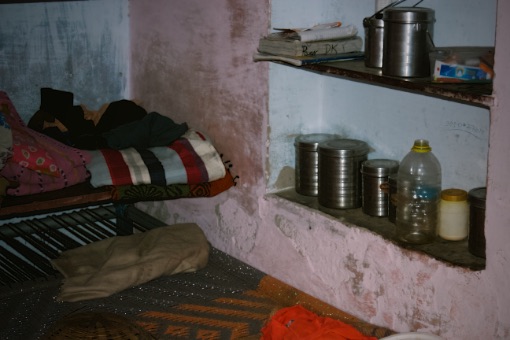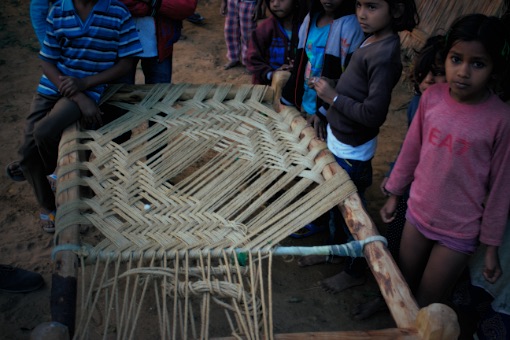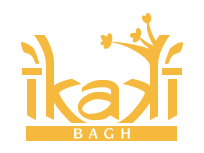

The charpoy bed is a traditional daybed. It is a common sight throughout India, particularly in rural areas.
Making a charpoy requires exceptional skills in traditional rope weaving and carpentry. These skills are under threat in the face of the industrialisation.
The Berwa people living in communities near Ikaki Bagh are renowned rope weavers and skilled charpoy makers.
Visitors to Ikaki Bagh can see charpoy making first-hand. This will directly support the maintenance of this tradition and the local communities.
What is a charpoy?
A charpoy is a flatbed of woven webbing stretched on a wooden from on four legs. It is appealingly modest in design. Simple, readily available materials are typically used.
The charpoy is used as a:
- daybed for resting
- platform for public speaking or religious preaching
- platform for small communal meetings
The charpoy is also known charpai, charpai, khatiya, khaat or manji all literally meaning ‘four feet’.
Elaborate or highly decorated charpoys are historically less common and reserved for privileged classes.
Today, the traditional charpoy is experiencing a revival with a modern twist. Versions in bright colours and modern materials have become popular among the fashion-conscious consumers in the cities, as well an export opportunity.
History
Daybeds can be traced to ancient civilisations in Mesopotamia, Egypt and Greece.
Speculation on the origins of the daybed in Indian traditional life varies. Some argue it was brought by invading armies as early as Alexander the Great. Others argue the design evolved in the local region on its own.
The charpoy was sufficiently widespread to attract the attention of Ibn Battuta, the great 14th century Moroccan scholar. This widely-travelled explorer wrote in 1350:
The beds in India are very light. A single man can carry one and every traveller should have his own bed, which his slaves carries about on his head. The bed consists of four conical legs on which four staves are laid; between the plait a sort of ribbon of silk or cotton. When you lie on it you need nothing else to render the bed sufficiently elastic.
Today daybeds based on the same basic design are widespread throughout south-east Asia, Pakistan, Bangladesh and India. Charpoys were also a common sight among Indian immigrants who settled in other British colonies, such as Malaysia.
Unlike other age-old traditional items such as the charka, or spinning wheel, the charpoy never found a place of symbolism in political activism.
However, the humble charpoy is also experiencing something of a modern revival and makeover with versions in bright colours and modern materials popular among the fashion-conscious consumers in the cities.
Making a traditional charpoy
The traditional charpoy is a common sight throughout rural India, especially in warmer regions.
Its humble character belies the high level of skill involved making a long-lasting charpoy.
The frame requires four wooden uprights and four horizontal timbers. These are connected using a mortice and tenon joint. The timber used can be as simple as tree trunks or limbs. The main requirement is the timber is sufficiently straight and strong.
A mortice and tenon joint is mostly used to connect pieces of wood at a ninety-degree angle and its use can be traced back thousands of years to ancient civilisations. The simplicity of this joint provides the strength of its construction.
The four wooden legs and horizontal timbers of the frame provide a rectangular space. This space is filled with a tightly woven network of ropes made from natural fibres such as cotton, jute, date palms or coir, a fibre taken from coconut husks.
Experienced charpoy weavers move quickly and methodically. The most important requirement is to create a platform of equal tension using tight interweaving and tying techniques with knots.
Many charpoy weavers take the opportunity to create distinctive designs and patterns to enhance the charpoy’s visual appeal.
First a knurled crossband is fixed horizontally, approximately a fifth of the distance along the frame. The main seating is then woven and then held in place by a series of tensions strings. Screws, nail or glue are never used in charpoy making.
Berwa people and rope-making
The Berwa people are especially skilled in making ropes and mats from locally available fibre sources.
Charpoy frames are made with a variety of wooden material including local trees and re-using frames from wooden beds and the like.
In the district around Ikaki Bagh, most charpoys are made using the Babool Tree, also known as the Kikar Tree. Incidentally, the bark of the Babool tree has traditionally been used for cleaning teeth.
The woven webbing of charpoys is made from whatever materials can be readily obtained. The most commonly used material is rope made from jute or synthetic rope. The length of rope used depends on the size of the charpoy but a typical 6’ x 4’ model might use up to 1500 feet (450m) of rope.
The traditional practice of using locally grown Kunchey grass is uncommon these days being replaced by modern materials.
The variety of materials used results in wide variations in patterns, designs and textures. Two experienced weavers would complete one charpoy in three days, working at least six hours per day.
Visitors to Ikaki Bagh are welcome to visit the nearby Jhinjha Village to:
- see charpoy making first-hand
- try their hand at traditional rope-making and weaving
- commission or buy a charpoy direct from the makers
Supporting the maintenance of traditional charpoy making skills provides micro-economic development opportunities for local communities. It diversifies income for communities and mitigates the risk caused by crop failure and severe climatic events that occur in this region.
